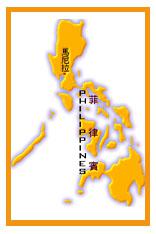
菲律賓共和國
- 首頁
- /
- 民俗風情
- /
- 菲律賓共和國
菲律賓共和國(Republic of the Philippines)
簡 介
地理菲律賓共和國(Republic of the Philippines)位於我國南方,全國共由7,107個島嶼組成(其中約880個島有人居住),陸地總面積共300,439平方公里。呂宋(Luzon)、民答那峨(Mindanao)兩大島分據南北,共約佔全國總面積66.4%。其最北端島嶼距台灣南端僅52.8公里,為我國最近之鄰邦。
與台灣以巴士海峽相隔的菲律賓,由7,107個島嶼組成,其中有人居住的島嶼僅2,000座,而另有2,500座島嶼還沒命名;呂宋(Luzon)和民答那峨(Mindanao)是全境最大島,全國人口亦多集中於此。四散分布的島嶼無疑對菲國經濟造成不少影響,然而開發不異而保存下來的原始,更是難能可貴的資產。

氣候
菲國靠近赤道,屬海洋性熱帶氣候,全年大致分乾、濕兩季,6月至10月為雨季,11月至次年5月為乾季。年平均溫度為攝氏26.7度,元月最涼,3月至5月最熱。每年7月至12月間有颱風,雨季經常淹水,導致塞車、停電及停工。 2000年5月人口7,650萬,2004年估計人口約8,270萬。
當地華僑約有100萬人,近年我國人至菲國經商、應聘或投資留學者逐漸增加,據估計我旅菲國人近萬人。
語言
菲全國有87種語言,以菲語(Tagalog)為國語,另以英語為官方及教學語言。
人種
人種基本上以馬來人為主,加上移民入境之華人、西班牙人、美國人及印度人,以及馬來人與上述移民之混血種,構成今日菲國多種族之社會。
菲律賓可分為小黑人、印度尼西亞人、馬來人三大種族及八十七個族群團體。其中以馬來種人最多,目前菲律賓人大多是屬於馬來人。除了上述菲律賓原住民的種族外,菲律賓的人口還有一個特色,就是混血族(Mestizos),包括菲、華混血,菲、美混血,及菲、西混血,這是東南亞其他國家所沒有的現象。
Races
There are three main ethnic groups in the Philippines: Negritos, Indonesians and Malays. There are also 87 other ethnic minorities. Malays make up the bulk of the population; most people who live in the Philippines today are Malays. In addition to the native inhabitants, the population of the Philippines also includes Mestizos, people of mixed descent, including admixtures of Chinese, Filipino, American and Spanish ancestry. This is a unique phenomenon in Southeast Asia.
宗教
在西班牙人佔領菲律賓,建立殖民地政府之前,菲人的社會結構係依部落組織方式,以酋長為領袖,實施統治管理運作,這種部落社會也曾建立過兩個小回教王國,但是在菲律賓尚未發展出屬於自己本身特色的文化前,就已落入西方勢力的控制。雖然它與中國、印度和阿拉伯人早有接觸,但因地理的阻隔,並未在文化或宗教上受到影響或洗禮。因此,菲律賓受到西方勢力的影響程度,甚過於受到其他東南亞國家或其他亞洲強勢文化國家的影響,也形成菲國是東南亞國家中信奉天主教之國家。
Religion
Before the Spanish invaded the Philippines and established colonial rule, the islands were inhabited by many small tribes and groups. People lived under the control of the tribal chiefs. Two small Islamic kingdoms had been established on the islands, but the Spanish brought them under their control before they could develop their own culture. Although the Philippines had contact with China, India and Arabia from very early on, the region had not been directly influenced because of the geographical barriers. As a result, Western culture had more influence in the Philippines than any of the other advanced civilizations of Southeast Asia. The Philippines is also the only Catholic country in Southeast Asia.